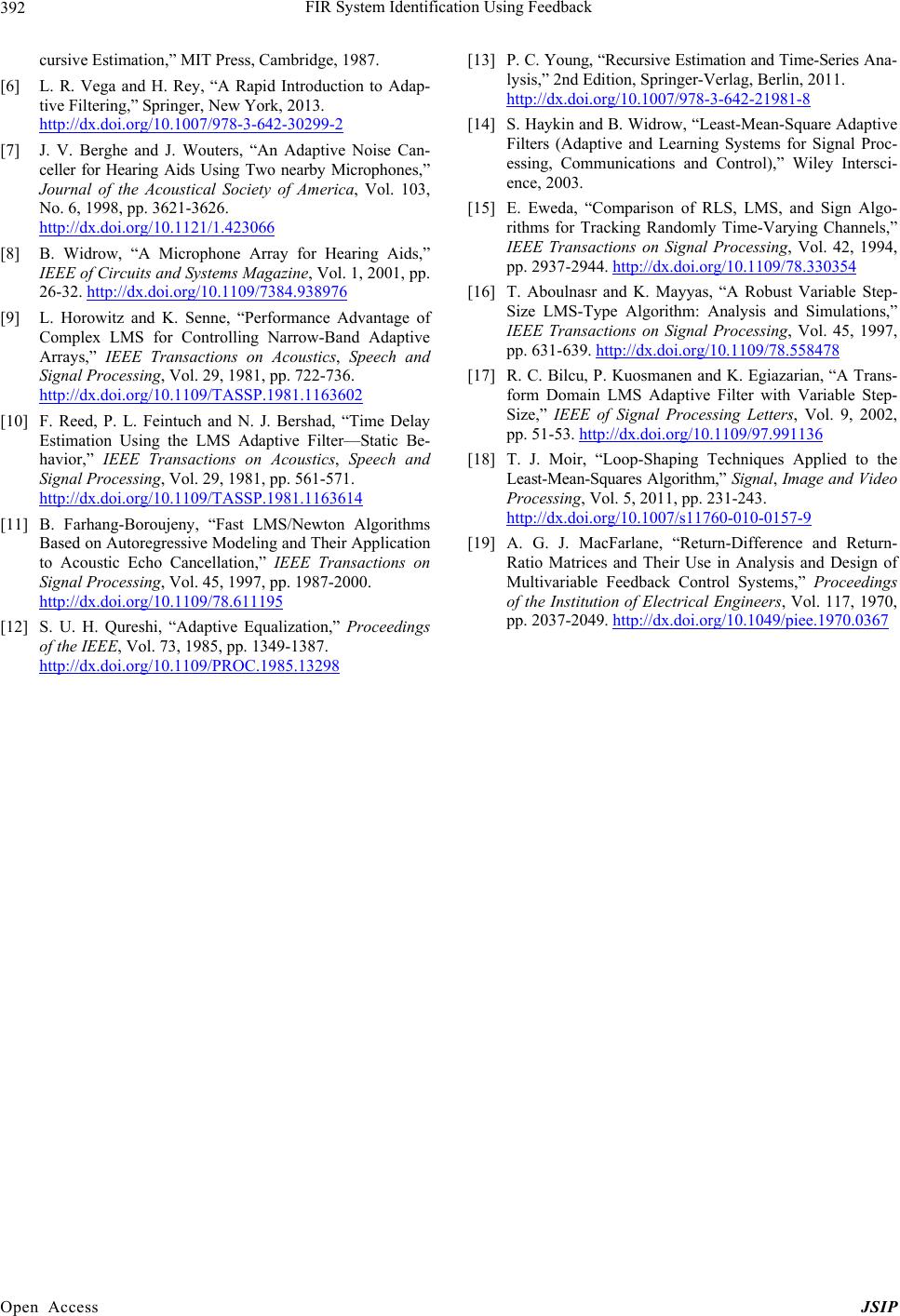
FIR System Identification Using Feedback
Open Access JSIP
392
cursive Estimation,” MIT Press, Cambridge, 1987.
[6] L. R. Vega and H. Rey, “A Rapid Introduction to Adap-
tive Filtering,” Springer, New York, 2013.
http://dx.doi.org/10.1007/978-3-642-30299-2
[7] J. V. Berghe and J. Wouters, “An Adaptive Noise Can-
celler for Hearing Aids Using Two nearby Microphones,”
Journal of the Acoustical Society of America, Vol. 103,
No. 6, 1998, pp. 3621-3626.
http://dx.doi.org/10.1121/1.423066
[8] B. Widrow, “A Microphone Array for Hearing Aids,”
IEEE of Circuits and Systems Magazine, Vol. 1, 2001, pp.
26-32. http://dx.doi.org/10.1109/7384.938976
[9] L. Horowitz and K. Senne, “Performance Advantage of
Complex LMS for Controlling Narrow-Band Adaptive
Arrays,” IEEE Transactions on Acoustics, Speech and
Signal Processing, Vol. 29, 1981, pp. 722-736.
http://dx.doi.org/10.1109/TASSP.1981.1163602
[10] F. Reed, P. L. Feintuch and N. J. Bershad, “Time Delay
Estimation Using the LMS Adaptive Filter—Static Be-
havior,” IEEE Transactions on Acoustics, Speech and
Signal Processing, Vol. 29, 1981, pp. 561-571.
http://dx.doi.org/10.1109/TASSP.1981.1163614
[11] B. Farhang-Boroujeny, “Fast LMS/Newton Algorithms
Based on Autoregressive Modeling and Their Application
to Acoustic Echo Cancellation,” IEEE Transactions on
Signal Processing, Vol. 45, 1997, pp. 1987-2000.
http://dx.doi.org/10.1109/78.611195
[12] S. U. H. Qureshi, “Adaptive Equalization,” Proceedings
of the IEEE, Vol. 73, 1985, pp. 1349-1387.
http://dx.doi.org/10.1109/PROC.1985.13298
[13] P. C. Young, “Recursive Estimation and Time-Series An a-
lysis,” 2nd Edition, Springer-Verlag, Berlin, 2011.
http://dx.doi.org/10.1007/978-3-642-21981-8
[14] S. Haykin and B. Widrow, “Least-Mean-Square Adaptive
Filters (Adaptive and Learning Systems for Signal Proc-
essing, Communications and Control),” Wiley Intersci-
ence, 2003.
[15] E. Eweda, “Comparison of RLS, LMS, and Sign Algo-
rithms for Tracking Randomly Time-Varying Channels,”
IEEE Transactions on Signal Processing, Vol. 42, 1994,
pp. 2937-2944. http://dx.doi.org/10.1109/78.330354
[16] T. Aboulnasr and K. Mayyas, “A Robust Variable Step-
Size LMS-Type Algorithm: Analysis and Simulations,”
IEEE Transactions on Signal Processing, Vol. 45, 1997,
pp. 631-639. http://dx.doi.org/10.1109/78.558478
[17] R. C. Bilcu, P. Kuosmanen and K. Egiazarian, “A Trans-
form Domain LMS Adaptive Filter with Variable Step-
Size,” IEEE of Signal Processing Letters, Vol. 9, 2002,
pp. 51-53. http://dx.doi.org/10.1109/97.991136
[18] T. J. Moir, “Loop-Shaping Techniques Applied to the
Least-Mean-Squares Algorithm,” Signal, Image and Video
Processing, Vol. 5, 2011, pp. 231-243.
http://dx.doi.org/10.1007/s11760-010-0157-9
[19] A. G. J. MacFarlane, “Return-Difference and Return-
Ratio Matrices and Their Use in Analysis and Design of
Multivariable Feedback Control Systems,” Proceedings
of the Institution of Electrical Engineers, Vol. 117, 1970,
pp. 2037-2049. http://dx.doi.org/10.1049/piee.1970.0367